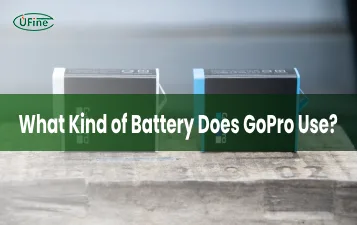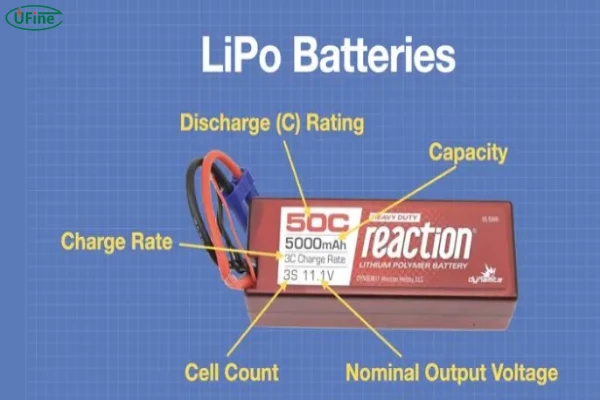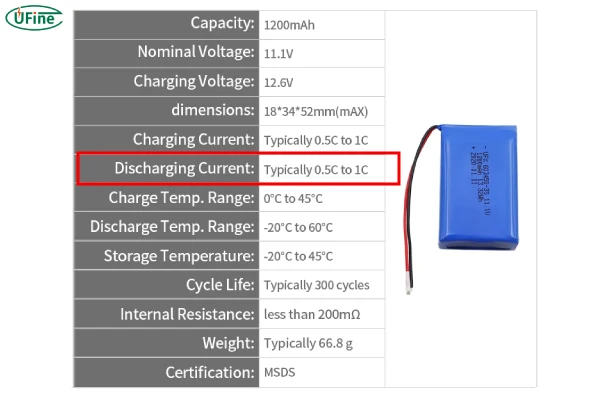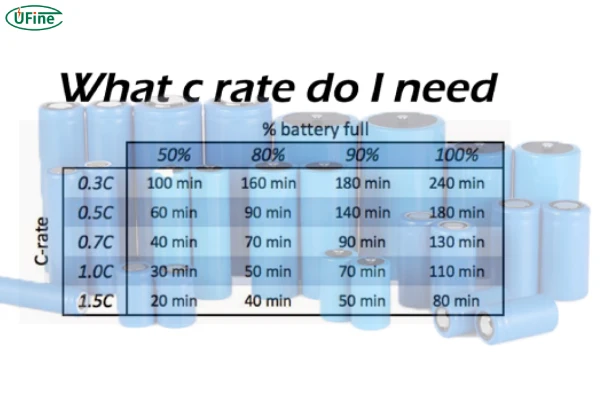LiPo batteries (Lithium Polymer batteries) are essential for many electronic devices, from drones to RC cars. But one term that often pops up is “C rating.” What does it mean? Why is it important? This guide will help you navigate the complexities of C ratings, helping you make informed choices for your battery needs.
Part 1. What does C rating on LiPo battery mean?
The C rating of a LiPo battery is a crucial specification that tells you how much current the battery can safely discharge. In simple terms, it indicates the maximum continuous discharge rate of the battery relative to its capacity. The higher the C rating, the more power the battery can deliver.
Common LiPo Battery C Ratings
You might see various C ratings on LiPo batteries, often ranging from 1C to 100C or more. Here’s a breakdown:
- 1C: This means the battery can discharge its entire capacity in one hour. For instance, a 2200mAh battery at 1C can deliver 2.2 amps continuously.
- 10C: This indicates the battery can discharge ten times its capacity in one hour. So, a 2200mAh battery can provide 22 amps.
- 20C and above: These are typically designed for high-performance applications, like racing drones or high-speed RC cars, allowing for quick bursts of power.
Understanding these ratings is essential because they directly affect the performance and safety of your devices.
Part 2. Where can I check the C rating of my LiPo battery?
Finding the C rating of your LiPo battery is usually a straightforward task. Most manufacturers print the C rating on the battery label itself, often alongside other specifications like voltage and capacity.
If you can’t find it on the label, don’t worry! You can also check:
- Product Documentation: The manual or documentation that came with your battery will likely include the C rating.
- Manufacturer’s Website: Most reliable manufacturers list detailed specs for their products online, so you can verify the C rating before making a purchase.
- Online Retailers: Websites selling LiPo batteries often include specifications in the product description, making it easy to find what you need.
Always make sure you’re purchasing from reputable sources to avoid misleading information.
Part 3. How does C rating affect LiPo battery performance?
The C rating significantly impacts how your battery performs in various situations. Here are several key factors to consider:
- Discharge Rate: A higher C rating means the battery can discharge power more rapidly, which is crucial for high-drain applications. If you’re using your battery in a racing drone, for example, you’ll need that quick burst of energy for speed and agility.
- Heat Generation: Batteries with low C ratings may struggle to provide the required current, leading to overheating. This can damage the battery, shorten its lifespan, or even cause safety hazards.
- Flight Time and Efficiency: For drones and RC vehicles, a higher C rating can lead to better performance and longer run times. You won’t have to worry about your battery giving out mid-flight, allowing you to enjoy your hobby without interruptions.
Understanding how these factors interact can help you make better choices for your setups.
Part 4. How to calculate the C rating of a LiPo battery?
Calculating the C rating of a LiPo battery is relatively simple and can empower you to understand your battery’s capabilities better. You can use this straightforward formula:
Current (A)=Capacity (Ah)×C Rating
Example Calculation
Let’s break it down with a practical example. Suppose you have a 3000mAh battery with a 15C rating. First, convert the capacity to amp-hours (Ah):
- 3000mAh = 3.0Ah
Now, multiply this by the C rating:
3.0Ah×15C=45A
This means your battery can safely provide up to 45 amps of current without risking damage.
Another Example
Let’s say you have a 2200mAh battery with a 25C rating. Here’s how you calculate it:
- Convert mAh to Ah: 2200mAh = 2.2Ah
- Multiply by the C rating:
2.2Ah×25C=55A
In this case, your battery can deliver up to 55 amps.
Part 5. Is the higher the C rating, the better?
While it might seem logical that a higher C rating is always better, this isn’t necessarily the case. Here are some important considerations:
- Weight and Size: Batteries with higher C ratings often come in larger and heavier packages. If you’re flying a lightweight drone, a high-C battery might not be the best choice. Balance is key!
- Cost: High-C batteries tend to be more expensive. If you don’t need the extra discharge capability, you could end up wasting money. Always assess your needs before making a purchase.
- Application-Specific Needs: Not all applications require high C ratings. For casual flying or less demanding tasks, a lower C battery may suffice.
So, it’s essential to choose a C rating that fits your specific needs rather than just opting for the highest number available.
Part 6. Applications of LiPo battery that need a high C rating
Certain applications demand a higher C rating to perform optimally. Here are some common scenarios:
- Racing Drones: These machines require quick bursts of power for acceleration and maneuverability. A higher C rating ensures they can handle the demands of fast-paced flying.
- RC Cars and Trucks: High speeds and rapid acceleration drain batteries quickly, necessitating a higher C rating to maintain performance.
- Aerial Photography Drones: When lifting heavy payloads like cameras, a higher C rating helps maintain stability and performance.
- Multirotors: For acrobatic flying, more power is essential to execute complex maneuvers.
If you’re involved in any of these activities, opting for a battery with a higher C rating is crucial.
Part 7. Is the C rating of LiPo battery real or marketing? How to check it?
You may wonder if the C ratings advertised are genuine or just marketing hype. Unfortunately, this can sometimes be a gray area. Some manufacturers might inflate their C ratings to attract buyers.
To ensure you’re getting a reliable C rating:
- Research Brands: Stick to well-known and reputable brands. Look for reviews and user feedback to gauge reliability.
- Test Reports: Some hobbyist communities conduct tests on batteries. Seek out independent reviews that provide insight into real-world performance.
- Check Forums: Online forums can be a treasure trove of information, helping you determine which brands are trustworthy and which might be overstating their specs.
Part 8. What C rating do I need?
Determining the right C rating for your needs involves considering a few factors:
- Application: Identify what you’re using the battery for. Racing? Aerial photography? This will guide your C rating requirement.
- Vehicle Specs: Check your RC vehicle or drone’s specifications. Most will indicate the recommended C rating for optimal performance.
- Current Draw: Estimate how much current your setup will draw during use. If you plan to push your equipment hard, lean towards a higher C rating.
In summary, understanding your needs and doing a little research will help you select the most suitable C rating for your LiPo battery.
Part 9. Conclusion
In conclusion, the C rating on LiPo batteries is more than just a number. It plays a vital role in determining your battery’s performance, safety, and suitability for various applications. By grasping the concepts of C ratings, how to check them, and their implications on performance, you can make better choices for your hobby or project.
Whether you’re a seasoned expert or a beginner, knowing how to navigate the world of LiPo batteries can significantly enhance your experience. So, take the time to understand these ratings, and you’ll be well on your way to enjoying the best performance from your devices!
Related Tags:
More Articles

What Battery Powers Your GoPro?
Learn all about GoPro batteries - compatibility, runtime, charging tips, and how to extend battery life for longer shoots.
What Is a Disk Battery? A Simple Guide for Non-Tech Users
A disk battery is a small, round cell used in watches, remotes, and other electronic devices. It delivers steady power for compact, low-drain devices.
What Battery Powers a Space Heater?
Discover the type of battery that powers space heaters and learn how to choose the right one for efficient heating in your home or office.
What Is an LR14 Battery? Learn About This C-Size Cell
The LR14 battery, also known as a C battery, delivers steady power. Learn its specs, uses, lifespan, and how it compares to other battery types.
Watch Battery Dimensions Chart: Sizes, Voltages, and Equivalents Explained
Understanding watch battery dimensions helps you choose the right size, voltage, and equivalent model to keep your watch running safely and smoothly.






